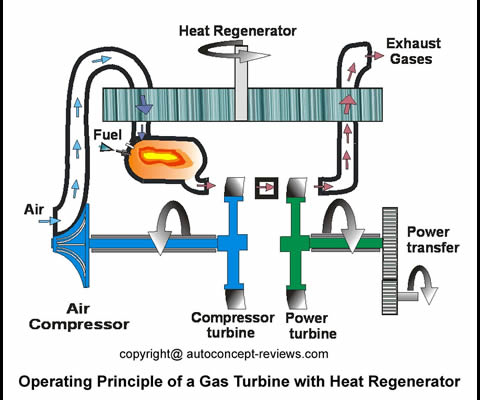Toyota GTV Gas Turbine Vehicle 1987
The Toyota GTV Research Vehicle introduced at the 1987 Tokyo Motor Show is a Supra-based coupe testbed for Toyota’s experimental automotive gas turbine. The GT41 two-shaft gas turbine produces 150 bhp JIS at an output shaft speed of 5.300 rpm and a maximum torque of 34 kg-m at 1.000 rpm. The gas generator, comprised of a centrifugal compressor and a radial-in-flow turbine, has a rated rpm of 68.000 and the axial flow turbine with variable nozzles at 53.000 rpm. It incorporates a low-speed rotating type exchanger that recovers waste heat from the exhaust gases and transfers it to the incoming compressed air.
Power is transmitted from the power turbine’s output shaft via a reduction gear train to a torque-converter-and-planetary-gear automatic transmission whose shift timing is optimally chosen by the electronic control unit that monitors the engine’s power output and torque.
Toyota has been working on gas turbine projects continuously since 1964, in an effort to seek an alternative prime mover for automotive use.
The GTV does not have an inside rear view mirror, instead it has been replaced by a six-inch color CRT whose vision is captured by a charge-coupled-device camera hidden in the rear lamp cluster.
The drawing on the right shows a simplified view of the operating principle of a gas turbine with regenerator. A gas turbine comprises only rotating parts which avoid vibrations. In a gas turbine, hot gases are generated in continuous in the combustor; the combustion can combine a great variety of fuels with compressed air supplied by the compressor. In a two shaft gas turbine, the first shaft support to air compressor and is rotated by the effect of the combustion gases on the primary turbine. The same combustion gases propel a power turbine on the second shaft that is connected to the power transfer. The rotating regenerator recovers the heat from the combustion gases and transfers it to the compressed air for higher fuel efficiency. |
 |
Gas turbines have the capability of utilizing a wide variety of fuels, and there was a good possibility that ceramic materials can be used in the future to improve their thermal efficiency.
As of today, the gas turbine for automobile did not access to production in view of high production cost and fuel consumption.